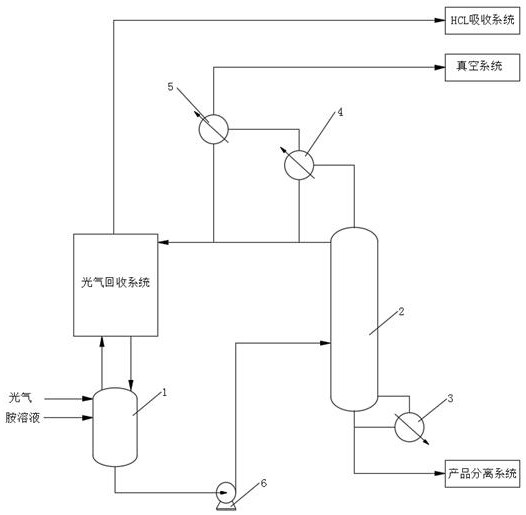A kind of phosgene removal method of m-xylylene diisocyanate
A technology of m-xylylene diisocyanate and phosgene, which is applied in the field of phosgene removal of m-xylylene diisocyanate, can solve problems such as difficult removal of phosgene, improve safety and reduce consumption The effect of volume and load reduction
- Summary
- Abstract
- Description
- Claims
- Application Information
AI Technical Summary
Problems solved by technology
Method used
Image
Examples
Embodiment 1
[0023] The mixed solution of amine and o-dichlorobenzene with a concentration of 4.8% and a flow rate of 1000 kg / h and phosgene with a temperature of -10°C and a flow rate of 278 kg / h are carried out in photochemical reactor 1 for cold-hot photochemical reaction. The HCL gas and excess phosgene produced after photochemical pass into the phosgene recovery system; the reacted photochemical liquid contains XDI, o-dichlorobenzene, phosgene and HCL, its temperature is 138℃, and the flow rate is 1481kg / h. The phosgene content is 2.5% and the isocyanate content is 4.0%. The photochemical liquid discharge pump 6 is continuously fed into the phosgene removal tower 2 for rectification. The operating pressure of the phosgene removal tower 2 is -0.2barg; The mixed gas such as solvent and phosgene from the top of tower 2 enters the first-stage condenser 4 at the top of the tower, and its temperature is controlled at 40°C; the uncondensed gas enters the second-stage condenser 5 at the top of ...
Embodiment 2
[0025] The mixed solution of amine and o-dichlorobenzene with a concentration of 4.8% and a flow rate of 1000kg / h and phosgene with a temperature of -10°C and a flow rate of 278kg / h are carried out in photochemical reactor 1 for cold-hot photochemical reaction. The HCL gas and excess phosgene produced after photochemical pass into the phosgene recovery system; the reacted photochemical liquid contains XDI, o-dichlorobenzene, phosgene and HCL, its temperature is 138℃, and the flow rate is 1481kg / h. The phosgene content is 2.5% and the isocyanate content is 4.0%. The photochemical liquid discharge pump 6 is continuously passed into the phosgene removal tower 2 for rectification. The operating pressure of the phosgene removal tower 2 is -0.1barg; The mixed gas such as solvent and phosgene from the top of tower 2 enters the first-stage condenser 4 at the top of the tower, and its temperature is controlled at 30°C; the uncondensed gas enters the second-stage condenser 5 at the top of...
Embodiment 3
[0027] The mixed solution of amine and o-dichlorobenzene with a concentration of 4.8% and a flow rate of 1000kg / h and phosgene with a temperature of -10°C and a flow rate of 278kg / h are carried out in photochemical reactor 1 for cold-hot photochemical reaction. The HCL gas and excess phosgene produced after photochemical pass into the phosgene recovery system; the reacted photochemical liquid contains XDI, o-dichlorobenzene, phosgene and HCL, its temperature is 139℃, and the flow rate is 1481kg / h. The phosgene content is 2.5% and the isocyanate content is 4.0%. The photochemical liquid discharge pump 6 is continuously passed into the phosgene removal tower 2 for rectification. The operation pressure of the phosgene removal tower 2 is -0.5barg; The mixed gas such as solvent and phosgene from the top of tower 2 enters the first-stage condenser 4 at the top of the tower, and its temperature is controlled to 50℃; the uncondensed gas enters the second-stage condenser 5 at the top of ...
PUM
 Login to View More
Login to View More Abstract
Description
Claims
Application Information
 Login to View More
Login to View More - R&D
- Intellectual Property
- Life Sciences
- Materials
- Tech Scout
- Unparalleled Data Quality
- Higher Quality Content
- 60% Fewer Hallucinations
Browse by: Latest US Patents, China's latest patents, Technical Efficacy Thesaurus, Application Domain, Technology Topic, Popular Technical Reports.
© 2025 PatSnap. All rights reserved.Legal|Privacy policy|Modern Slavery Act Transparency Statement|Sitemap|About US| Contact US: help@patsnap.com

